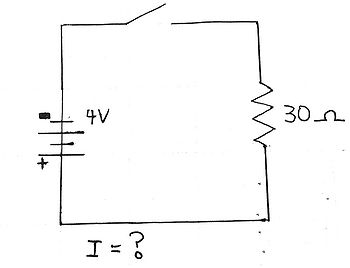Series Circuit
Jump to navigation
Jump to search
claimed by Mchan46
Main Idea
- A Series Circuit is a simple type of electrical circuit in which components are placed in succession of one another.
- The electrical connection is not branched in any way. One can visualize this circuit as simply a closed loop.
- Often times, the simple series circuit may include but are not limited to: a number of resistors, switches, and of course, batteries.
- Keep in mind, if there is an open switch or break in the circuit, no current flows.
A Mathematical Model
- Kirchhoff's Current and Voltage Laws apply in a series circuit.
- Through Kirchhoff's Current Law, we know that the sum of all current going in must equal the sum of all current going out.
- [math]\displaystyle{ \sum{I}_{in} - \sum{I}_{out} = 0 }[/math]
- Since there are no nodes for the current to split up, the current throughout a series circuit will always be the same through each component.
- Through Kirchhoff's Voltage Law, the sum of all voltage in a closed system must be zero.
- [math]\displaystyle{ \sum{V}_{Battery} - \sum{V}_{Components} = 0 }[/math]
- Through Kirchhoff's Current Law, we know that the sum of all current going in must equal the sum of all current going out.
- Ohm's Law is extremely useful in finding the voltages, resistances, and current throughout the series circuit.
- Ohm's Law gives us the following formula:
- [math]\displaystyle{ V=IR }[/math]; it can be rearranged to yield [math]\displaystyle{ I=\frac{V}{R} }[/math] and [math]\displaystyle{ R = \frac{V}{I} }[/math]
- Ohm's Law gives us the following formula:
- Total Resistance in a series circuit is the sum of all resistances. It can be used to find the overall current in the circuit, which can then be used to find individual resistances.
- Total resistance is described by:
- [math]\displaystyle{ R_T=\sum_{n=1}^N {R}_{Series}=R_1+R_2+R_3+...R_N }[/math]
- Total resistance is described by:
A Computational Model
- The best way to visualize a series circuit is to draw a schematic, which is a simplified representation of the circuit in real life.
- Resistors are usually represented in a schematic with

- Batteries are represented in a schematic by

- Switches can be open or closed. An open switch is represented by

Examples
For these examples, find the values specified.
Simple
Find the current in the circuit.
Middling
Find the voltage across the battery if the current in the circuit is 0.5 A
Difficult
The voltage across [math]\displaystyle{ R_1 }[/math] is 5 volts. The voltage across [math]\displaystyle{ R_2 }[/math] is 6 volts. What are the resistances of [math]\displaystyle{ R_1, R_2, }[/math] and [math]\displaystyle{ R_3 }[/math] if the current measured across [math]\displaystyle{ R_3 }[/math] is .65 A and the voltage of the battery is 16V?
Solutions to Examples
Simple
[math]\displaystyle{ I=0 }[/math] Since the circuit is open, there is no way for current to flow through the circuit.
Middling
- 1. Find Total Resistance
- [math]\displaystyle{ R_T=R_1+R_2+R_3=10+35+15=60 }[/math] Ohms
- 2. Use Ohm's Law (current is given already)
- [math]\displaystyle{ V=IR=0.5\bullet60=30 }[/math] Volts
Difficult
- 1. Note that current across a series circuit is the same.
- Current = 0.65 A
- 2. Sum of battery voltage is equal to the sum of all voltage across resistors.
- [math]\displaystyle{ \sum{V}_{Battery} = \sum{V}_{Components} }[/math]
- [math]\displaystyle{ 16 = 5 + 6 + V_3 }[/math]
- [math]\displaystyle{ V_3 = 5 }[/math]
- 3. Use the rearranged Ohm's Law to find the resistances.
- [math]\displaystyle{ R=\frac{V}{I} }[/math]
- [math]\displaystyle{ R_1=\frac{5}{.65}=7.69 }[/math] Ohms
- [math]\displaystyle{ R_2=\frac{6}{.65}=9.23 }[/math] Ohms
- [math]\displaystyle{ R_3=\frac{5}{.65}=7.69 }[/math] Ohms
Connectedness
- Series circuits are the most basic type of circuits.
- They are used in all electronics; even parallel circuits can be simplified into a series circuit!
- Some realistic applications include making lights, motors, and other electrical appliances work.
History
- Series circuits date as far back as when the first battery was invented.
- In the 1800's Alessandro Volta invented the first battery; it was originally used to produce hydrogen and oxygen from water.
- Around the 1880's, however, light bulbs were commercialized and used to illuminate cities- none of this could be done without the basic circuit.
See also
- Ohm's Law
- Resistors and Conductivity
- Current
- Ammeters,Voltmeters,Ohmmeters
- Power in a circuit
- RL Circuit
- LC Circuit
Further reading
- Matter & Interactions, Vol. II: Electric and Magnetic Interactions, 4nd Edition by R. Chabay & B.Sherwood (John Wiley & Sons 2015)
External links
References
- "All About Circuits - Electrical Engineering & Electronics Community." All About Circuits - Electrical Engineering & Electronics Community. Web. 30 Nov. 2015.
- "Build Electronic Circuits - Electronics Explained in a Simple Way." Build Electronic Circuits. Web. 30 Nov. 2015.
- Matter & Interactions, Vol. II: Electric and Magnetic Interactions, 4nd Edition by R. Chabay & B.Sherwood (John Wiley & Sons 2015)
- Soclof, Sidney. HowStuffWorks. HowStuffWorks.com. Web. 30 Nov. 2015.


